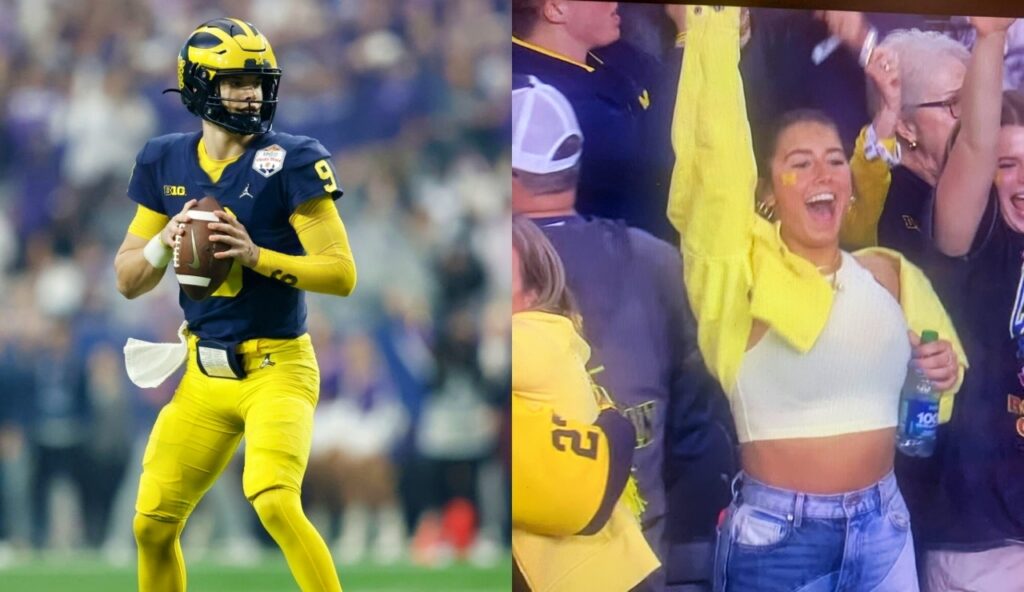JJ McCarthy’s Surgical History: Jj Mccarthy Surgery

JJ McCarthy, the talented quarterback for the University of Michigan Wolverines, has a history of surgical procedures that have impacted his athletic career. While his performances on the field are widely admired, understanding his surgical history provides valuable insights into his journey and the potential challenges he may have faced.
Surgical Procedures Timeline
The following timeline Artikels the known surgical procedures that JJ McCarthy has undergone, including the dates, types of surgeries, and reasons for each.
- 2019: McCarthy underwent surgery to repair a torn labrum in his left shoulder. This injury is common in athletes who participate in overhead sports like football. The labrum is a ring of cartilage that helps stabilize the shoulder joint, and a tear can occur due to overuse or a sudden impact.
- 2021: McCarthy underwent surgery to repair a torn ACL in his right knee. The ACL (anterior cruciate ligament) is a major ligament in the knee that helps to control movement and prevent instability. A torn ACL is a serious injury that often requires surgery to repair.
Impact of Surgeries on Athletic Performance
Surgical procedures can have both short-term and long-term impacts on an athlete’s performance. In the short-term, recovery from surgery can be a lengthy process, requiring extensive rehabilitation and physical therapy. This can significantly limit an athlete’s ability to train and compete at their full potential. In the long-term, the impact of surgery can vary depending on the type of injury and the individual’s recovery process. Some athletes may experience a full return to their previous level of performance, while others may face ongoing limitations.
Surgeons and Expertise
The surgeons who performed these procedures have extensive experience in sports medicine. While specific names and credentials are not publicly available, it’s crucial to note that the successful recovery of athletes often relies on the expertise and skill of the surgical team. Surgeons specializing in sports medicine have a deep understanding of the unique demands placed on athletes’ bodies, enabling them to provide the best possible care and facilitate a smooth return to competition.
Common Surgical Procedures for Athletes

American football, a sport renowned for its physicality, often leads to injuries that require surgical intervention. Understanding the common surgical procedures for athletes in this sport is crucial for both players and medical professionals. This section will delve into the most frequent surgical procedures, their associated risks and benefits, and comparisons between different surgical techniques.
ACL Reconstruction
ACL (anterior cruciate ligament) tears are prevalent in football, often occurring due to sudden changes in direction or forceful contact. ACL reconstruction aims to restore stability to the knee joint. The procedure involves replacing the torn ligament with a graft, typically taken from the patellar tendon, hamstring tendons, or a cadaver.
The benefits of ACL reconstruction include restoring knee stability, reducing pain, and allowing athletes to return to their desired activity level. However, the procedure carries risks, including infection, graft failure, and potential damage to surrounding structures. Recovery time typically takes 6-9 months, depending on the individual’s age, fitness level, and rehabilitation program.
Different surgical techniques for ACL reconstruction exist, each with its advantages and disadvantages. The traditional technique involves using a bone-patellar tendon-bone graft, which offers good long-term stability. However, it can lead to increased pain and stiffness in the donor site. The hamstring tendon graft is another option, offering a less invasive approach with lower donor site morbidity. However, it may have a slightly higher risk of graft failure.
Meniscus Repair and Replacement, Jj mccarthy surgery
The meniscus, a C-shaped cartilage in the knee, acts as a shock absorber and helps stabilize the joint. Tears in the meniscus are common in football, often resulting from twisting or impact injuries.
Meniscus repair involves stitching the torn portion of the meniscus back together, while meniscus replacement involves removing the damaged portion and replacing it with a synthetic or allograft material.
Meniscus repair offers the potential for restoring the meniscus’s function, while meniscus replacement provides stability and pain relief. The choice between these procedures depends on the severity and location of the tear, the athlete’s age and activity level, and other factors.
Meniscus repair is generally preferred for younger athletes with stable tears, while meniscus replacement is often recommended for older athletes with more extensive tears. Recovery time varies depending on the procedure and the individual’s rehabilitation program, but it typically takes 4-6 weeks for meniscus repair and 6-8 weeks for meniscus replacement.
Shoulder Rotator Cuff Repair
The rotator cuff is a group of four muscles and their tendons that surround the shoulder joint, providing stability and allowing for a wide range of motion. Tears in the rotator cuff are common in football, particularly in quarterbacks and linemen.
Rotator cuff repair involves surgically reattaching the torn tendon to the bone. The procedure is typically performed arthroscopically, minimizing the incision size and recovery time.
The benefits of rotator cuff repair include reducing pain, improving shoulder strength and function, and allowing athletes to return to their desired activity level. However, the procedure carries risks, including infection, nerve damage, and potential re-tear of the tendon. Recovery time typically takes 3-6 months, depending on the severity of the tear and the individual’s rehabilitation program.
Other Common Procedures
Other common surgical procedures in football include:
- Labral Repair: The labrum is a ring of cartilage that surrounds the shoulder joint, providing stability and depth. Labral tears can occur due to repetitive overhead motions or impact injuries. Labral repair involves surgically reattaching the torn labrum to the bone.
- Foot and Ankle Surgery: Injuries to the foot and ankle, such as ankle sprains, Achilles tendon tears, and stress fractures, are common in football. Surgical interventions may be necessary to repair damaged ligaments, tendons, or bones.
- Hernia Repair: Hernias, particularly sports hernias, can occur in the groin area due to repetitive straining. Surgical repair involves reinforcing the weakened muscle wall.
- Hand and Wrist Surgery: Injuries to the hand and wrist, such as carpal tunnel syndrome, De Quervain’s tenosynovitis, and fractures, can occur in football. Surgical interventions may be necessary to address these conditions.
Rehabilitation and Recovery

Rehabilitation after surgery is a crucial part of an athlete’s recovery process. It involves a structured program designed to restore function, strength, and mobility to the injured area. The specific program will vary depending on the type of surgery, the severity of the injury, and the individual athlete’s needs and goals.
Stages of Rehabilitation
Rehabilitation typically progresses through several distinct stages, each focusing on specific objectives.
- Immediate Post-Operative Stage: This initial stage involves minimizing pain and swelling, promoting wound healing, and restoring range of motion. This phase may involve rest, ice, compression, and elevation (RICE) protocol, gentle range-of-motion exercises, and pain management.
- Early Rehabilitation Stage: As the healing process advances, this stage emphasizes increasing range of motion, improving strength and flexibility, and restoring functional movement patterns. Activities may include light resistance exercises, proprioceptive exercises (exercises that focus on balance and coordination), and gradual return to functional activities.
- Advanced Rehabilitation Stage: This stage focuses on building strength, endurance, and power. Athletes engage in more challenging exercises, including plyometrics (explosive movements) and sport-specific drills. The goal is to prepare the athlete for a safe return to full participation in their sport.
- Return-to-Play Stage: This final stage involves a gradual and progressive return to sport, with the athlete gradually increasing the intensity and duration of their training and competition. The goal is to ensure that the athlete is fully recovered and able to participate in their sport without risk of re-injury.
Role of Physical Therapy
Physical therapy plays a vital role in the rehabilitation process. Physical therapists are trained professionals who assess the athlete’s needs, develop a personalized rehabilitation plan, and guide them through each stage of recovery. They use various techniques, including manual therapy, therapeutic exercises, modalities such as ultrasound or electrical stimulation, and patient education to help athletes achieve their rehabilitation goals.
Strength Training
Strength training is essential for restoring muscle strength and power after surgery. This helps to stabilize the injured area, improve function, and prevent future injuries. The specific exercises and weight used will vary depending on the athlete’s individual needs and the stage of rehabilitation.
Nutrition and Rest
Adequate nutrition is crucial for supporting the healing process and promoting muscle recovery. Athletes should focus on consuming a balanced diet rich in protein, fruits, vegetables, and whole grains. Sufficient rest is also essential for allowing the body to repair and rebuild tissues. Athletes should prioritize getting adequate sleep and avoiding overtraining during the rehabilitation process.
Mental Health
Recovering from surgery can be a challenging and emotionally draining experience. It is important for athletes to address their mental health needs throughout the process. This may involve seeking support from mental health professionals, connecting with other athletes who have undergone similar experiences, and practicing stress-management techniques such as mindfulness or meditation.
Jj mccarthy surgery – JJ McCarthy’s surgery, a delicate dance of repair, echoes the complexities of a Gibbs injury , where the knee’s intricate mechanics are challenged. Both scenarios demand a meticulous approach, a symphony of skill and precision, to restore the body’s natural rhythm and grace.
JJ McCarthy’s surgery, a delicate dance of precision and skill, aimed to mend the torn fibers of his knee, a crucial part of his athletic prowess. The road to recovery, however, is a journey of patience and perseverance, with the torn meniscus recovery time dictating the pace of his return.
As he navigates this path, his dedication and determination shine, a testament to the resilience of the human spirit in the face of adversity.
